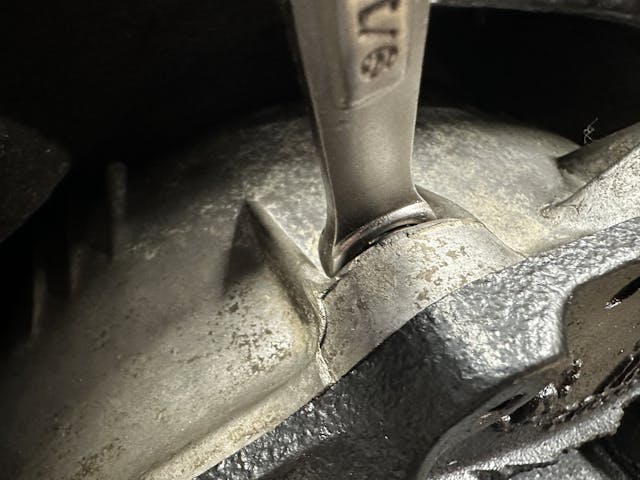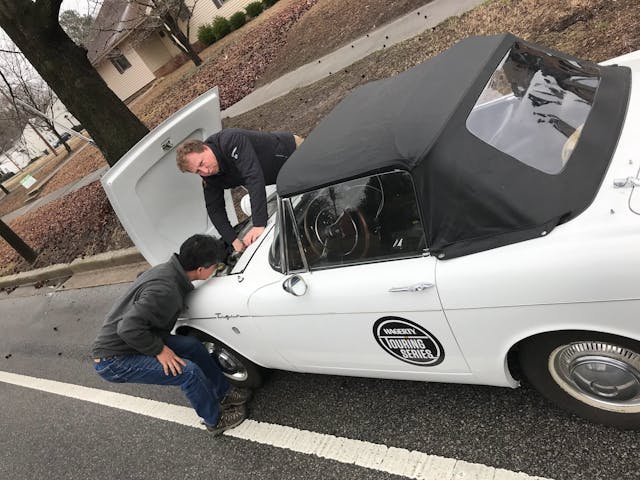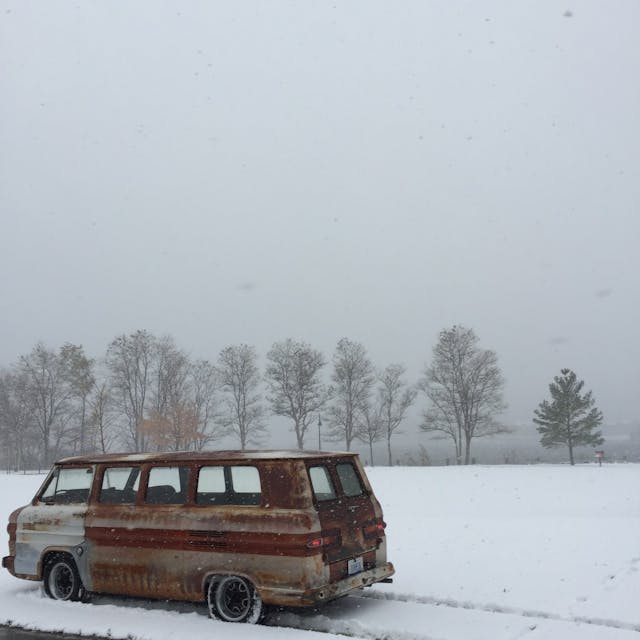Media | Articles
11 Rites of Passage for Every DIY Mechanic
Read all the books you want. Watch all the TV shows and YouTube mechanic videos that have ever been filmed. Sit and have a conversation with everyone who has turned a wrench. You still won’t be a mechanic, because practice and experience cannot be taught.
When younger enthusiasts recount certain adventures (or misadventures) to those with a few more years in the hobby, the seasoned folks will nod along. A mechanic’s rites of passage often need no explaining; by definition, these experiences have become universally accepted as ones that you must encounter and conquer to become proficient.
Which of these 11 rites of passage have you experienced, and which do you think changed you the most?
Rite of Passage #1: Roadside repair with makeshift parts
Whether on the road or in the shop, there comes a time when what you have is all you’ve got, and what you have just needs to work. Gaskets cut out of beer packaging, throttle cables made of shoestrings, or bailing wire on a part or piece that should be properly connected, but isn’t … If you understand a system well enough to engineer a functional fix on the fly, you truly understand how that system works.
Rite of Passage #2: Busted knuckles
You know the bolt is about to break free, so you give it a little extra oomph—and slam your hand into something. Usually, that something is heavy, rusty, or sharp … possibly, all three. Keep a record of your last tetanus shot handy, and know that we’ve all been there. Pulling towards yourself is often safer, except when it comes to cutting tools or other sharp implements.
Marketplace
Buy and sell classics with confidence
Rite of Passage #3: Trapped tools

The order of operations during disassembly and assembly is important—but you’ve got to pay attention to your tools, too. We’ve all been in situations when the excitement of a bolt coming loose makes us forget the limited space we’re working with, and suddenly our wrench is trapped between a bolt and a hard place.
Rite of Passage #4: Broken hardware

When a bolt chooses to Marie Antoinette itself, or threads stretch past the plasticity point and become unusable, progress can get tough. The fact of the matter is that rookies are more likely to break hardware, but there is a bit of a bell curve: As you tackle more and more projects, the quality of your work often rises; and then, as you gain confidence to handle the problems you now expect to encounter, the quality of your work tends to dip. Learning new methods for dealing with broken and stuck hardware is a never-ending quest for any wrench, green or seasoned.
Rite of Passage #5: Buying the shop manual
Just about everyone went through a phase when they felt as though they knew everything. Most advance out of such a state to understand that, even with everything they know, the shop manual knows more. Learning just how important and helpful a shop manual can be is often a freeing experience: Buying one is the first step to being self-sufficient because it allows you to solve problems without calling in experts or endlessly searching the web.
Rite of Passage #6: Disappearing parts
How else are you going to learn to organize your shop if you never experience the mildly panicked search for something you sat down right there? Everyone who ever gave you advice about doing DIY work probably told you to bag and tag parts and hardware, but most of us had to learn the benefits of organization the hard way to truly understand them.
Rite of Passage #7: Endless parts search

You saw that cool hunk of metal on the side of the road and just had to have it. Now you got it home and are excited to get to work and … Wait, there are no parts available for this? Sometimes the coolest models are the ones with the most problems and buying one that needs everything without realizing none of the parts exists is the gearhead’s version of falling in love with a crazy person: You often can’t give them what they need, and if you try, you’re going to be doing a lot of work (and probably spending a lot of money).
Rite of Passage #8: First rebuilt engine start-up
The thrum of a well-tuned engine is magnificent, but the stutter and cough of one chugging to life for the first time is even more enthralling. Was everything assembled correctly? Was anything forgotten? How is the combination of parts you chose going to work together? It all becomes clear with the first touch of the key. Weathering that storm of nerves is an experience unlike any other.
Rite of Passage #9: Ruined clothes
It was supposed to be a quick, clean job. Now that pair of jeans that used to be nice is stained with oil. (The situation is even worse if you’ve just ruined a pair of pants that your significant other specifically told you not to wear in the garage.) Typically when doing DIY work you dress to protect, not to impress. Hubris may protest, calling that an obvious truth, but the drawer of “work clothes” indicates we occasionally need a reminder.
Rite of Passage #10: Inclement weather moving in
Having a garage is a luxury that some of us take for granted. Most of us started by working on whatever we had wherever we could: Laying on our backs in gravel driveways, sitting cross-legged on the dirt of the back yard, or even leaning over core supports on the side of the street. If the sun was shining when you started work, your lack of protection from the elements becomes obvious as the clouds gather and the wind picks up. Being soaking wet, cold, and/or dirty while trying to assemble or diagnose your car is not fun, but we all must experience this misery to truly appreciate mild weather and good shelter.
Rite of Passage #11: Fixing what is not broken
The excitement to work on a project is sometimes so great that it must be satiated—even when there is work that needs to be done. I personally recall my father giving me the “if it ain’t broke, don’t fix it” speech while in my early teens; I had just made a mess of the garage floor taking apart something that had worked when I started and, more than likely, would never work correctly again. Poor thing.
Do you have to go through all of these to be a decent mechanic? Of course not, but many of us have experienced most, if not all, of these and more. Think we missed a rite of passage that changed you? Let us know about it in the comments below.
***
Check out the Hagerty Media homepage so you don’t miss a single story, or better yet, bookmark it. To get our best stories delivered right to your inbox, subscribe to our newsletters.














1 Army roommate rebuilt his VW. Had a few parts left over. Car seized a week later.
2 While in the Army, two-and-a-half ton truck broke a short cable to the carb. My engineer buddy searched around the road and found a short piece of metal that he substituted for the cable. Worked fine.
3 Volvo turbo broke a part holding the turbo body. Two guys with 10 teeth between them fashioned a part from a three foot high stack of washers, screws, bolts, nuts and assorted gee-gnaws to get me back on the road. Volvo service dealer checked it a week later and pronounced the part as better than the factory original!
Hah, I have graduated I guess, reading the list I had encountered every single item!
Talk about fixing something that wasn’t broken. I guessed wrong when replacing a front wheel bearing in a GMC Envoy. So I took the one that I had just removed and used it to replace the bad one. Never had a problem with it.
’51 Studebaker pickup, flathead six, three on the tree. Bought for $45.00 cold hard cash. 1972, driving home in the dark from getting ice cream cones with my recently married wife and best friend sitting next to me. Engine dies on unlit stretch of ocean-side road. I find my way to the hood release, raise the hood, reach inside the pitch black engine compartment until my momentarily clean hands find the ignition coil. I deftly tighten the loosened ignition wire nut with now greasy fingers. Climb back into the truck, and to the amazement of my passengers, fire that muther up and head for home. I never mentioned that the offending coil nut had, sometime in it’s past, lost it’s lock washer and I had previously performed the same task, while alone, with the benefit of daylight. I was seen from that day forward as a “the dark prince of Studebaker”.
#1 The accelerator cable on my wife’s VW Beetle broke. She figured out that she could stick a pencil into the linkage to keep the revs up so that she could drive home. She had a father and a husband that worked on cars, we were both proud of her!
I had the throttle cable break on my 69 Lemans when I was in high school and needed to get home and replace the part later once I could locate and afford one, so I wrapped speaker wire around the throttle of the carburetor and ran it out the back of the hood and spooled the extra around the side view mirror so I could get in the car, unwrap it and have a hand throttle. I drove around like that for a coupe/few days and fixed it properly the following weekend. Good times…
Dropping the 10mm socket or any other tool will find the drain pan no matter how far away it is!
Oh, so many tales to tell, it’s fun to hear other’s. I’d agree with adding to the list going to the junkyard and having a fire or two. One to add (and yes, it’s rare) is finding and fixing a problem quickly for almost or no cost and impressing someone (hopefully of the opposite gender).
Rite of Passage #9: Ruined clothes
#9b – Still using them since they are already “ruined”.
Re. Roadside repairs: In my club rallying days soap patched holes in fuel tanks while wire, masking tape and duct tape fixed pretty much everything else.
About #10: My 70 year old brother could have done a lot of his own car maintenance and repair, but he never did. I asked him why. “Because when I was 20 years old, I spent too much time trying to rebuild a transmission with a screwdriver and a hammer while it was 25 below.” Good reason.
In the year it took me to get around to resurrecting the 1995 FZR1000 EXUP that had previously been “stored” for 28 years with regular gas in it, mice had gotten into the dog food and one kibble at a time filled the air box and every bit of open space in the bike with dog food and nesting material. Furthermore, the gas had turned to varnish and corroded the gas tank.
Super Stock wheels on a van? All right!
Having a part, especially true about fasteners left over when the job is “finished’ happens a lot to people and is a bit disturbing to me, but what is worse than that is finishing the job and then cleaning up, only to realize something was left out after the fact is worse.
Many years ago, I was working in a shop being pushed to hurry, I gave the boss/shop owner the keys and told him it was all set after I did front brakes including calipers and had road tested it.
When I went back to the bay and cleaned up, I drained my drain pan to notice a copper washer sitting it the bottom of the pan. It was a washer to seal the flex hose to the caliper! Oh no…
I brought the vehicle back in to install the washer and told my foreman what happened. He was amazed that I told him the brakes felt good during the test drive. He came over to look for himself and was further surprised that there was no sign of a leak. What helped was I had learned a technique from an older technician that worked for Chevrolet. When tightening that bolt, I would tighten it like normal, then back the bolt off a bit, then retighten it. The second time, the bolt would always tighten a little more than the first time.
The owner walked in and saw the car back in the shop and started to ream me a new one when my foreman said that in my defense, it wasn’t leaking.
I wish that was the only time I cleaned up after the job was “complete” only to find a part wasn’t installed, but I guess I’m a little slow and a little dense. I’m hoping I am better now – only time will tell.
Replacing an oil filter and not wiping the block clean to verify the old rubber seal came off with the filter thus double gasketing the new filter. Many technicians make this mistake once. I had a newbie do this several times to the point that I saw him with the bag of speedy dry in the parking lot and decided to ask him if he was trying to get himself fired. Some people learn slower than others, while others just don’t seem to care to learn from their mistake.
Be honest of your limitations. Side note-manual choke cable can be adapted to accelerator cable on 1960 AH. Bugeye.